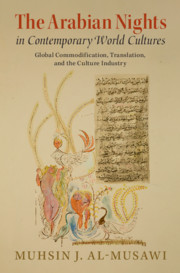 The Arabian Nights in Contemporary World Cultures
The Arabian Nights in Contemporary World Cultures Published online by Cambridge University Press: 17 August 2021
Chapter 6 starts with the understanding of the advent of the Nights as “a major event for all European literature,” a point that Borges and others argue passionately. In order to see the impact of this event we need to differentiate the Romantic craze of William Beckford in his Vathek, Episodes, and “Long Story,” his translators, and also his admirers from others. Beckford was phenomenal in working across at least three cultures along with Arabic: French, English, and Jamaican. His infatuation and reproduction of the Nights is unique, but we have to place it in context of a raging discussion run by many, but especially Schlegel, of the grotesque and Arabesque. His writing and personal penchant to challenge everything presents him as a filiate who belongs to a specific genealogy in the Nights. His approach is different for instance from the Brontës whose writings bear the marks of a contained infatuation. They are the bridge for twentieth-century shifts in reading and response. A “murky sensualism” which Maxime Rodinson associates with “the Western bourgeoisie” prepares for the dialectic of rapprochement, engagement, and detachment that present the twentieth century and after as more experimental but also no less involved in substantiating the Nights in architecture, painting, enactment of medieval travels, and the practice of parody and pastiche in a postmodernist anxiety and search for distinction.
To save this book to your Kindle, first ensure [email protected] is added to your Approved Personal Document E-mail List under your Personal Document Settings on the Manage Your Content and Devices page of your Amazon account. Then enter the ‘name’ part of your Kindle email address below. Find out more about saving to your Kindle.
Note you can select to save to either the @free.kindle.com or @kindle.com variations. ‘@free.kindle.com’ emails are free but can only be saved to your device when it is connected to wi-fi. ‘@kindle.com’ emails can be delivered even when you are not connected to wi-fi, but note that service fees apply.
Find out more about the Kindle Personal Document Service.
To save content items to your account, please confirm that you agree to abide by our usage policies. If this is the first time you use this feature, you will be asked to authorise Cambridge Core to connect with your account. Find out more about saving content to Dropbox.
To save content items to your account, please confirm that you agree to abide by our usage policies. If this is the first time you use this feature, you will be asked to authorise Cambridge Core to connect with your account. Find out more about saving content to Google Drive.